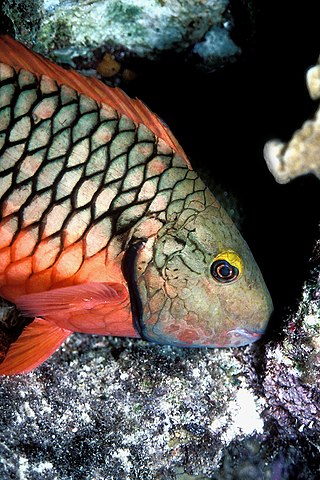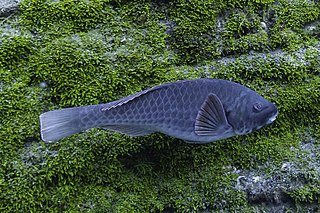
Parrotfish are a group of fish species traditionally regarded as a family (Scaridae), but now often treated as a subfamily (Scarinae) or tribe (Scarini) of the wrasses (Labridae). With roughly 95 species, this group's largest species richness is in the Indo-Pacific. They are found in coral reefs, rocky coasts, and seagrass beds, and can play a significant role in bioerosion.

Sparisoma is a genus of parrotfishes native to warmer parts of the Atlantic. FishBase recognizes 15 species in this genus, including S. rocha described from Trindade Island in 2010 and S. choati described from the East Atlantic in 2012. They are the most important grazers of algae in the Caribbean Sea, especially since sea urchins, especially Diadema, the other prominent consumers of algae, have been reduced in many places by a recent epidemic.

The stoplight parrotfish is a species of marine ray-finned fish, a parrotfish from the family Scaridae, inhabiting coral reefs in Florida, Caribbean Sea, Gulf of Mexico, Bermuda and as far south as Brazil. It mainly feeds on algae by scraping and excavating it with its teeth. Like most of its relatives, it is able to change sex.

The Mediterranean parrotfish is a species of parrotfish found at depths up to 50 m (160 ft) along rocky shores in the Mediterranean and the eastern Atlantic, from Portugal south to Senegal. It is generally common, but uncommon or rare in the northwestern Mediterranean and in the Adriatic Sea. It prefers relatively warm temperatures and there is an ongoing northward range expansion, possibly due to global warming. The primary adult habitat is rocky reefs, especially in areas with macroalgae, but they may visit adjacent seagrass patches. Juveniles also occur more widely in the latter habitat.

The rusty parrotfish is a species of marine ray-finned fish, a parrotfish belonging to the family Scaridae. It is associated with reefs in the north western Indian Ocean and the Red Sea.

The queen parrotfish is a species of marine ray-finned fish, a parrotfish, in the family Scaridae. It is found on reefs in the tropical West Atlantic Ocean and the Caribbean Sea. Other common names include blownose, blue chub, blue parrotfish, blueman, joblin crow parrot, moontail, okra peji and slimy head. The young males and adult female queen parrotfish are a reddish-brown color, and quite different in appearance from the bluish-green color of the final phase male. This is a common species throughout its range and the International Union for Conservation of Nature has rated its conservation status as "least concern".

The mackerel icefish is a benthopelagic species of fish found in the Southern Ocean and the southernmost waters of the Atlantic Ocean. They are mainly to be found near Heard and McDonald Islands, Îles Kerguelen and islands in the south Atlantic such as South Georgia and Bouvet Island. The species also inhabits the northern waters of the Antarctic Peninsula. They live at depths of 0–700 metres (0–2,297 ft), but are commonly found at depths of 30 to 250 metres.
Sparisoma tuiupiranga is a species of marine ray-finned fish, a parrotfish from the family Scaridae. It has a single midventral scale posterior to the insertion of the pelvic fins. Its distribution extends from 18°S to 27°S in the western Atlantic, off the coast of Brazil. This species is found in shallow areas of tropical rocky reefs. The males establish territories of approximately eight square metres. The juveniles have a strong association with seaweed beds where they occasionally mix with Sparisoma radians and Cryptotomus roseus. It grazes on a wide variety of algae growing on rocks and so ingests a large amount of sediment. It can be adaptable in its feeding habits and is frequently seen feeding over Sargassum.

Chilomycterus reticulatus, the spotfin burrfish, spotted burrfish, Pacific burrfish, spotfin porcupinefish or few-spined porcupinefish, is a species of fish in the genus Chilomycterus, which is part of the porcupinefish family Diodontidae.

Scarus frenatus is a species of parrotfish. Common names include bridled parrotfish, sixband or six-banded parrotfish or vermiculate parrotfish.

Sparisoma chrysopterum is a species of parrotfish.

Sparisoma aurofrenatum is a species of parrotfish native to the Caribbean Sea and Western Atlantic Ocean.

The goldtail angelfish, also known as the earspot angelfish, is a species of marine ray-finned fish, a marine angelfish belonging to the family Pomacanthidae. It is found in the western Indian Ocean.

Calotomus carolinus, commonly known as Carolines parrotfish, is a species of marine ray-finned fish, a parrotfish, in the family Scaridae. It is also known as the starry-eye parrotfish, stareye parrotfish, bucktooth parrotfish, Christmas parrotfish or marbled parrotfish. Since the Calotomus carolinus is known across the Pacific, it also has its own name in many native languages for example, it is called a panuhunuhunu in the Hawaiian language.

Cetoscarus ocellatus, common name Spotted parrotfish, is a species of parrotfish belonging to the family Scaridae.

Scarus psittacus, the common parrotfish, is a species of marine ray-finned fish, a parrotfish, in the family Scaridae. Other common names for this species include the palenose parrotfish, Batavian parrotfish and the rosy-cheek parrotfish. It has a wide distribution in the Indo-Pacific region where it is associated with coral reefs. This species is utilised as food. It is the type species of the genus Scarus.

Sparisoma rocha or Trindade parrotfish is a species of parrotfish endemic to the islands of Trindade and Martin Vaz in southeastern Brazil. The species can be distinguished from its congeners easily by its coloration. S. rocha is a herbivore, grazing on algae that grows on rocks or coralline substrate.

Sparisoma choati, the West-African parrotfish, is a species of marine ray-finned fish from the family Scaridae. It occurs at depths between 2 and 30m, along west African coastline and islands from Cape Verde and Senegal south to the offshore islands of the Gulf of Guinea and northern Angola. Like other parrotfish of the genus Sparisoma, it lives on rocky reefs and grazes on algae growing over hard substrate. It was named in honor of J. Howard Choat, in recognition of his extensive scientific work on parrotfishes.
Zu elongatus, or the taper-tail ribbonfish, is a species of ray-finned fish within the family Trachipteridae. The species distribution is poorly known, and while it likely lives in temperate and tropical waters of all oceans, but has only been encountered in the Atlantic Ocean- off the coasts of Namibia and the western Cape of South Africa- and in the Pacific Ocean off New Zealand. It inhabits mesopelagic waters up to 1200 meters below sea level. Other common names for this species include "scalloped dealfish" and spitsstert-lintvis in Afrikaans.

Scarus zelindae is a species of fish of the Scaridae family in the order Perciformes. This species of Parrotfish can be brown, blue, green, yellow, and purple and can change their colors several times throughout their lifetime. They live for about 5–7 years and can be found in the southwestern Atlantic Ocean, primarily in Brazilian waters.

















